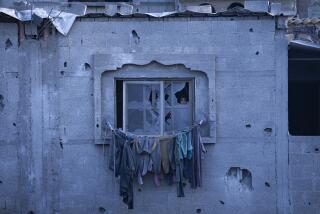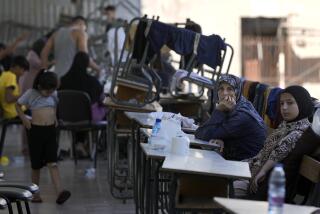‘Real Medicine’ : In World’s War Zones, Volunteer Doctors Race to Save Lives--and Hope
- Share via
Crouched in the bushes on the side of a road in southern Mogadishu, Dr. Broderick Franklin prepared to face death.
Months before, Franklin had left the comfort of his home in Washington, D.C., and headed for Somalia, where he treated the victims of war and famine, sometimes seeing up to 60 patients a day at Mogadishu’s Digfer Hospital. Now, caught in the middle of a chaotic gun battle between his Somali escorts and bandits who wanted their cars, it seemed his desire to help would cost him his life.
“I was ready to cash my chips in,” said Franklin, a member of the Los Angeles-based International Medical Corps. “I was thinking, ‘It’s been a good life. Does it have to end this way?’ ”
Franklin survived the ordeal, thanks to another group of Somalis who found him and arranged for his safe passage to a U.N. facility. By the next morning he was back at Digfer Hospital caring for patients and dealing with the more mundane aspects of working in a war zone.
“Nothing ever made me say, ‘I’m going home,’ ” Franklin said. “Even when a gun may have been pulled on me or when I became totally frustrated at having to combat a million flies in the hospital.”
From a suite overlooking Century Boulevard, in the shadow of Los Angeles International Airport, the IMC has sent hundreds of medical personnel like Franklin to war-ravaged countries since 1984, beginning with Afghanistan after the Soviet invasion.
Despite the danger, doctors, nurses and other medical personnel have left the relative safety of American hospitals and headed off to nations such as Angola, Afghanistan and Cambodia. Most simply want to help the victims of war-ravaged nations. Others want to see the world.
Whatever their reasons, these medical workers find themselves faced with the seemingly impossible: trying to save lives and heal broken bodies while surrounded by mass destruction and bloodshed.
But providing much-needed medical care to war victims is only part of IMC’s mission. The medical personnel and administrators also have established public health-care programs that focus on immunization and health education, and in some countries a chain of health clinics. To ensure that the programs will outlive IMC’s stay in any country, the organization also trains local doctors and health-care practitioners.
“It all goes back to self-sufficiency,” said Nancy A. Aossey, executive director and president of IMC. “While we get involved in giving direct relief, the thrust of everything we do revolves around training the local population to do for themselves what they are very capable of doing. They just need expertise in certain techniques--and resources.”
Over the years, the organization has sent nearly 350 doctors, 166 nurses and many physician’s assistants and other medical personnel to war-torn nations. The program also sends public-health workers, who run the health education components of the program, and logistics specialists, who oversee the day-to-day operation of the program, such as transportation, room and board. Currently, IMC has about 60 people working abroad.
“They have developed a particular niche for themselves,” said Andrew Natsios, a former assistant administrator with the U.S. Agency for International Development and current vice president of World Vision. “There are very few private voluntary organizations that will do this kind of work. . . . It’s very risky business.”
But IMC is no stranger to danger.
In 1984, Dr. Robert R. Simon, then an associate professor of medicine for the Division of Emergency Medicine at UCLA, read an article about the impact of the Soviet invasion on the health-care system in Afghanistan.
“Where there were 1,800 doctors before the war, only 200 remained,” said Simon, who is now chief of emergency services at Cook County Hospital in Chicago. The rest of the doctors had been either executed, imprisoned or exiled.
Outraged at the deaths and by the fact that “the world wasn’t responding,” Simon decided to go to Afghanistan.
“The rural health-care system and hospitals had been destroyed,” Simon said. “It was basically done to force people to leave the country, to depopulate--and it worked. One third of the entire population went into refugee camps.”
Using his own funds and other private donations, Simon created IMC after several well-established relief agencies told him they could not oversee a clinic he set up on his visit to Afghanistan.
“The charters of most international relief organizations will not let them work in places where the governments don’t want them to be,” he said.
IMC assists those most in need of medical care and training--whether the government wants them there or not. It is a private, nonprofit organization that receives funding from individuals, corporations and foundations, as well as from the USAID, the Office of U.S. Foreign Disaster Assistance, the World Health Organization and the European Community.
Dr. Eric Savitsky spent the summer working at a hospital in Zenica, Bosnia, while the city was being shelled five to 10 times a day. The wounded from nearby villages were also taken to Zenica, but many never made it there.
“It was just remarkable the number of people who just died without getting medical help,” said Savitsky, a resident in disaster medicine at the Division of Emergency Medicine at UCLA.
The goal of the IMC program there is to set up an ambulance network and to train physicians in the latest trauma care techniques. Savitsky and other American doctors taught Bosnians theory in conference rooms at Zenica Hospital. Their lab was the morgue, where they used the unclaimed bodies of those killed in the war to demonstrate and practice new techniques.
With no electricity for air-conditioning and lights, and no chemicals to preserve the corpses, working in the morgue at Zenica three hours a day, two days a week was a challenge in itself.
“When you picture a morgue here you think of a metal table, with a white sheet, air-conditioned, a very sterile environment,” Savitsky said. “There it’s a hot, dark room with a horrible stench. It’s full of fully clothed dead bodies, most covered with dust and dirt, holding in their hands exactly what they were holding when they died.”
The group used five translators--three Muslims, one Serb and one Croat--reflecting the backgrounds of the Bosnian physicians. But there were other barriers even more formidable than language.
“The first thing you have to do is prove yourself,” Savitsky said. “You can tell in their eyes, their looks, their mannerisms, that they’re used to being sold out by the West.”
When the doctors realized the impact the procedures would have on their patients, “they were very grateful, very happy,” and by the end of the training session, deep friendships had been formed between the Bosnian and American doctors, Savitsky said.
There are many reasons why IMC medical personnel and administrators shun the advice of well-meaning friends and family and voluntarily place themselves in a war zone, but money is not one of them, said Ken Ferber, IMC communications manager. Those who sign up for short-term stints--one to two months--receive no compensation. The organization pays their air fare to the country and their room and board. Those who sign up for longer programs, at least six months, receive only a small stipend.
For Simon, the work is a way to make a contribution, to make the world “a little better” than it was when he found it. It also allows him to practice medicine in its purest form.
“Here, you have all this medical/legal garbage purely to make lawyers rich . . . you have a situation where you can’t move without worrying about a lawsuit. You go overseas and you just practice real medicine. You just go and take care of people.”
For Savitsky, it was a way to help, to work with Simon, who is well-respected in his field, and to see the conflict close-up--a conflict that he now believes is not accurately portrayed in the media. Within his Zenica neighborhood, he saw Serbs, Muslims and Croats living side by side in peace. He listened to kids who were not so different from him.
“When I got there one of the first things the kids asked me was, ‘Who’s winning, the Bulls or the Knicks?’ ” Savitsky said. “These were kids who were watching MTV up until the electricity got cut off.”
No IMC worker has been killed or injured in fighting, but there were times, Franklin said, when death lurked right behind a tree or a bush.
The shoot-out between bandits and Franklin’s Somali escorts occurred on the first off-day he and other medical workers had had in months. As in other incidents, the bandits targeted the Somali escorts, not the mostly European medical workers in the cars. For Franklin, though, that was no solace.
“Of all the volunteer workers, I was the only one who was black,” Franklin recalled. “From 50 yards away in the dark, in the middle of a gunfight, I was just another black man crouching in the bushes.”
The shoot-out was the most dangerous situation Franklin confronted, but every day at Digfer Hospital, where Franklin and other IMC personnel worked, presented its own set of challenges.
Every day, the hospital was besieged by flies. Medical supplies and equipment and fuel for electricity were extremely limited. At one point, there were no drapes, no gowns, no scrub sinks.
In these situations, doctors and others like Franklin often end up providing even more than medical treatment and training.
“He was a boost to the morale of the people,” Aossey said. “Many people have lost family members. They feel totally isolated from the rest of the world. Dr. Franklin’s attitude was, ‘Let’s work together.’ ”
And that attitude is at the heart of the program.
“We want to restore not just skills, not just resources--but hope,” Aossey said.
More to Read
Sign up for Essential California
The most important California stories and recommendations in your inbox every morning.
You may occasionally receive promotional content from the Los Angeles Times.










